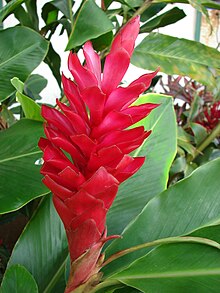Zingiberales
This article includes a list of references, related reading, or external links, but its sources remain unclear because it lacks inline citations. (January 2013) |
| Zingiberales Temporal range: Late Cretaceous - Recent
| |
|---|---|

| |
| Alpinia purpurata, a popular ornamental of the Zingiberaceae. | |
| Scientific classification | |
| Kingdom: | |
| (unranked): | |
| (unranked): | |
| (unranked): | |
| Order: | Zingiberales |
The Zingiberales are an order of flowering plants. The order has been widely recognised, at least for the past few decades, and includes many familiar plants, such as ginger, cardamom, turmeric, galangal and myoga in the Zingiberaceae or ginger family, bananas and plantains in the Musaceae or banana family, arrowroot in the Marantaceae or arrowroot family, Ravenala, Phenakospermum and Bird of Paradise flower in the Strelitziaceae family, along with various types of heliconias in the Heliconiaceae family.
Species of the Zingiberales order, together with those of the Commelinales order, are thought to have evolved around 80 million years ago during the Late Cretaceous.
Classification
The APG III system, of 2009, and the APG II system (2003) recognize this order and assign it to the clade commelinids, in the monocots. It is circumscribed as:
- order Zingiberales
- family Cannaceae (e.g.: Canna)
- family Costaceae (e.g.: Costus, Spiral Ginger)
- family Heliconiaceae (e.g.: Heliconias)
- family Lowiaceae (e.g.: Orchidantha)
- family Marantaceae (e.g.: Arrowroot)
- family Musaceae (e.g.: Banana, Ensete, Plantain)
- family Strelitziaceae (e.g.: Strelitzia, Ravenala, Phenakospermum)
- family Zingiberaceae (e.g.: ginger, cardamom, turmeric, galangal, Shell Ginger, myoga, Red Ginger, Summer Tulip)
The Cronquist system also recognised this order consisting of the same eight families, but organized the order in the subclass Zingiberidae of the class Liliopsida monocotyledons.
Earlier systems, such as the Wettstein system, last revised in 1935, and the Engler system, updated in 1964, recognised a similar order (containing the same plants, although divided over fewer families) Scitamineae.

